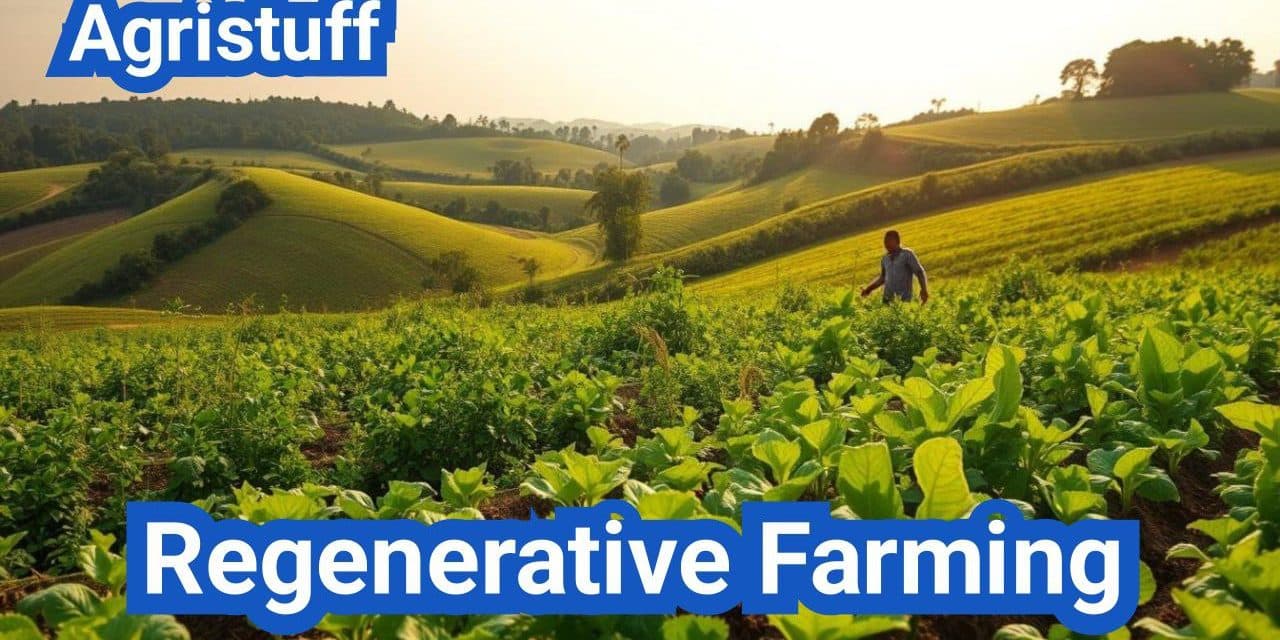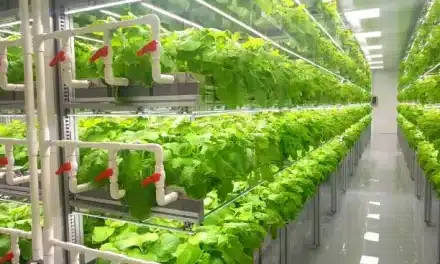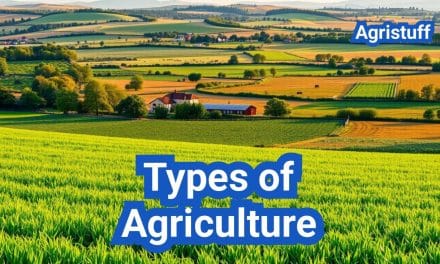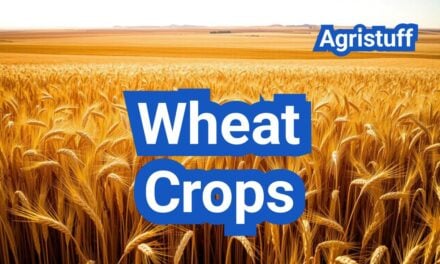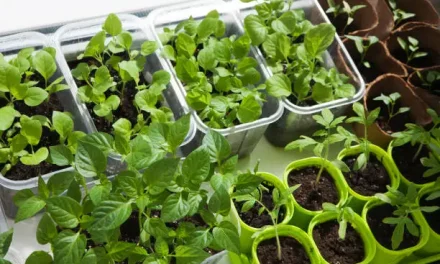Regenerative agriculture is transforming the way we think about farming and sustainability. By harnessing the power of photosynthesis, this holistic land-management practice sequesters carbon in the soil, enhancing soil health, crop yields, and water resilience.
This approach to sustainable agriculture not only improves the health of our ecosystems but also contributes to environmental sustainability. As the world grapples with climate change, regen farming emerges as a critical strategy for mitigating its impacts.
Key Takeaways
- Understanding regenerative agriculture and its benefits.
- The role of regenerative farms in sustainable agriculture.
- How regenerative farming contributes to environmental sustainability.
- Practical steps to implementing regenerative agriculture practices.
- The future of regenerative farming and its potential impact.
What Is Regenerative Farming?
Regenerative farming represents a significant shift in how we approach agriculture, moving beyond sustainability to actively regenerate the health of our ecosystems. This approach to farming is not just about producing food; it’s about creating a system that improves the environment, supports biodiversity, and enhances ecosystem services.
The Core Definition and Philosophy
At its core, regenerative farming is a philosophy that aims to regenerate the health of the soil, improve biodiversity, and enhance ecosystem function. It’s based on the understanding that the health of our soils, waters, and biodiversity is intricately linked to the way we grow our food. As Gabe Brown, a pioneer in regenerative agriculture, notes, “Regenerative agriculture is about regenerating the soil, the ecosystem, and the community.” The core definition revolves around practices that enhance soil organic matter, improve soil structure, and promote ecological balance.
“The goal is to leave the land in a better condition than when we started farming it,” says a regenerative farmer. This philosophy is rooted in a deep respect for the land and a commitment to improving it for future generations.
How Regenerative Farming Differs from Conventional Agriculture
Regenerative farming differs significantly from conventional agriculture in its approach and outcomes. While conventional farming often relies on synthetic fertilizers, pesticides, and intensive tillage, regenerative farming focuses on natural amendments, minimal soil disturbance, and cover cropping. These practices not only reduce the environmental impact but also enhance the resilience of the farming system.
One of the key differences is the emphasis on soil health. Regenerative farming prioritizes building soil organic matter, improving soil structure, and promoting soil biota. This approach contrasts with conventional farming, which often degrades soil health over time. As a result, regenerative farming can lead to improved water retention, reduced erosion, and increased biodiversity.
By adopting regenerative practices, farmers can contribute to carbon sequestration, improve water quality, and enhance ecosystem services. This holistic approach to agriculture is gaining recognition for its potential to address some of the most pressing environmental challenges of our time.
The History and Evolution of Regenerative Agriculture

Regenerative agriculture draws its foundational principles from the ancient agricultural practices of native cultures around the world. This approach to farming is not a new concept but rather a revival and modernization of traditional methods that worked in harmony with the environment.
Indigenous Roots of Regenerative Practices
Indigenous communities have practiced regenerative agriculture for centuries, long before the term became popular. Their methods, passed down through generations, focused on working with nature rather than against it. Key practices included crop rotation, polyculture, and minimal soil disturbance, all aimed at maintaining soil health and biodiversity.
Traditional Ecological Knowledge (TEK) played a crucial role in indigenous agriculture. TEK encompasses the understanding and practices developed by indigenous peoples over centuries, including their observations about the land, climate, and ecosystems. This knowledge is invaluable in the context of modern regenerative agriculture.
Modern Development of the Regenerative Movement
The modern regenerative agriculture movement has been influenced by various factors, including the work of pioneers like Allan Savory, who introduced holistic management practices. The movement gained momentum as concerns about climate change, soil degradation, and biodiversity loss grew.
| Key Figure | Contribution |
|---|---|
| Allan Savory | Introduced holistic management practices |
| Gabe Brown | Promoted regenerative practices through his farm |
The modern development of regenerative agriculture is characterized by its holistic approach, integrating ecological, economic, and social dimensions. As the movement continues to grow, it is likely to play a significant role in shaping the future of agriculture.
Why Regenerative Farming Matters Today
Regenerative farming has emerged as a critical strategy in addressing today’s environmental and agricultural challenges. As we face the pressing issues of climate change, soil degradation, and biodiversity loss, regenerative farming offers a holistic approach to producing food while enhancing ecosystem services.
Environmental Benefits and Climate Impact
Regenerative farming practices have been shown to have a positive impact on the environment. By promoting soil health, biodiversity, and efficient water use, regenerative farming can help mitigate climate change. Some of the key environmental benefits include:
- Carbon Sequestration: Regenerative farming practices like no-till or reduced-till farming, cover cropping, and incorporating organic amendments can help sequester carbon in soils.
- Improved Soil Health: Regenerative farming enhances soil organic matter, improves soil structure, and increases soil biodiversity, leading to more resilient farming systems.
- Biodiversity Conservation: By promoting ecological balance, regenerative farming helps conserve biodiversity, supporting a wide range of plant and animal species.
Economic Advantages for Farmers and Communities
In addition to its environmental benefits, regenerative farming also offers significant economic advantages for farmers and communities. Some of the key economic benefits include:
| Economic Benefit | Description | Impact |
|---|---|---|
| Increased Crop Yields | Regenerative farming practices can lead to improved soil health, resulting in higher crop yields. | Higher profitability for farmers |
| Reduced Input Costs | By promoting soil health and biodiversity, regenerative farming can reduce the need for synthetic fertilizers and pesticides. | Lower production costs for farmers |
| New Market Opportunities | Regenerative farming can open up new market opportunities for farmers, including premium prices for regeneratively produced products. | Increased revenue for farmers and rural communities |
By adopting regenerative farming practices, farmers and communities can not only contribute to a more sustainable environment but also improve their economic resilience. As the world continues to grapple with the challenges of climate change and environmental degradation, regenerative farming stands out as a vital strategy for creating a more sustainable food system.
The Five Core Principles of Regenerative Farming

At the heart of regenerative agriculture are five core principles designed to promote soil health, biodiversity, and ecosystem services. These principles work together to create a holistic farming system that not only sustains but also regenerates the natural environment.
Minimizing Soil Disturbance
Minimizing soil disturbance is crucial in regenerative farming. This principle advocates for reducing or eliminating tillage, which can damage soil structure and disrupt its ecosystem. By minimizing disturbance, farmers can preserve soil organic matter, reduce erosion, and promote soil biota. No-till or reduced-till practices are key strategies here.
Maintaining Soil Coverage
Maintaining soil coverage is another vital principle. This involves keeping the soil covered with organic materials such as crop residues, cover crops, or mulch. Soil coverage protects the soil from erosion, retains moisture, and provides a habitat for beneficial organisms. It also contributes to carbon sequestration by adding organic matter to the soil.
Enhancing Biodiversity
Enhancing biodiversity is fundamental to regenerative farming. This principle involves promoting a diverse range of crops, animals, and microorganisms within the farming system. Biodiversity enhances ecosystem services, improves soil health, and increases the resilience of the farm to pests, diseases, and climate change. Strategies include crop rotation, agroforestry, and integrating livestock into the farming system.
Keeping Living Roots in the Soil
Keeping living roots in the soil as much as possible is a principle that supports soil health and ecosystem functioning. Living roots help to stabilize the soil, increase soil organic matter, and provide food for beneficial microorganisms. This can be achieved through practices like cover cropping and perennial planting. No-till farming techniques also play a role here by minimizing soil disturbance and allowing roots to continue growing undisturbed.
Implementing No-Till Farming Techniques
No-till farming is a key technique for minimizing soil disturbance. It involves growing crops without tilling the soil, thus preserving soil health and reducing erosion. This method requires careful planning and management, including the use of cover crops and precise planting techniques. By adopting no-till farming, farmers can improve soil structure, increase water retention, and reduce the need for synthetic fertilizers and pesticides.
Essential Regenerative Farming Practices
Essential regenerative farming practices offer a pathway to more sustainable and productive farming. These practices are designed to enhance soil health, promote biodiversity, and improve the overall resilience of farming systems.
No-Till and Reduced Tillage Methods
No-till and reduced tillage methods are critical components of regenerative farming. By minimizing soil disturbance, these practices help preserve soil organic matter, reduce erosion, and promote soil biota. No-till farming, in particular, has been shown to improve soil health and reduce the need for external inputs.
Cover Cropping Strategies
Cover cropping is another essential practice in regenerative farming. It involves planting crops between cash crops to protect and enhance the soil. Cover crops help reduce soil erosion, improve soil fertility, and provide habitat for beneficial insects. Leguminous cover crops, for example, can fix nitrogen, reducing the need for synthetic fertilizers.
Crop Rotation Techniques
Crop rotation is a time-tested practice that involves rotating different crops on the same land to maintain soil fertility and control pests and diseases. By diversifying the crops grown, farmers can improve soil health, reduce the need for external inputs, and promote biodiversity. Crop rotation can also help in managing pests and diseases by breaking their life cycles.
Composting and Natural Amendments
Composting and the use of natural amendments are vital for maintaining soil fertility in regenerative farming systems. Composting involves breaking down organic materials to create a nutrient-rich soil amendment. This practice not only improves soil fertility but also helps in reducing waste by recycling organic materials. Natural amendments like compost can enhance soil structure, improve soil biota, and support plant health.
By adopting these essential regenerative farming practices, farmers can improve the sustainability and productivity of their farming operations. These practices not only benefit the environment but also contribute to the long-term viability of farming enterprises.
Implementing Regenerative Soil Practices

Regenerative agriculture begins with the soil, where practices like testing and conservation play a vital role. By focusing on regenerative soil practices, farmers can significantly enhance soil health, improve farm productivity, and contribute to a more sustainable agricultural system.
Soil Testing and Monitoring
Effective regenerative soil practices start with comprehensive soil testing and monitoring. This process involves assessing the soil’s physical, chemical, and biological properties to understand its current state and identify areas for improvement. Regular monitoring helps track changes over time, allowing farmers to adjust their strategies accordingly.
Building Soil Organic Matter
Building soil organic matter is a cornerstone of regenerative soil practices. This can be achieved through the use of cover crops, incorporating compost, and minimizing tillage. As soil organic matter increases, so does the soil’s water-holding capacity, aeration, and nutrient content, ultimately leading to healthier and more resilient soil.
“Soil is the foundation of our ecosystem, and its health is crucial for sustainable agriculture. By adopting regenerative practices, we can improve soil health, mitigate climate change, and ensure food security for future generations.”
Managing Soil Microbiome
The soil microbiome plays a vital role in soil health, influencing decomposition, nutrient cycling, and plant health. Regenerative soil practices aim to promote a diverse and thriving microbiome through the use of organic amendments, reduced tillage, and the incorporation of cover crops. By creating a favorable environment for beneficial microbes, farmers can enhance soil fertility and structure.
Water Management and Conservation
Effective water management and conservation are critical components of regenerative soil practices. Techniques such as mulching, cover cropping, and improving soil organic matter help enhance the soil’s water-holding capacity, reducing the need for irrigation and minimizing erosion. By adopting these strategies, farmers can improve soil health while also conserving this precious resource.
By implementing these regenerative soil practices, farmers can create a more sustainable and productive agricultural system. As the global community continues to grapple with the challenges of climate change, soil degradation, and food security, the importance of regenerative soil practices cannot be overstated.
Advanced Regenerative Farming Techniques

Beyond the basics, advanced regenerative farming techniques offer farmers new ways to improve soil health and biodiversity. These techniques build upon the foundational principles of regenerative agriculture, providing additional strategies to enhance ecological balance and farm productivity.
Agroforestry and Silvopasture
Agroforestry and silvopasture are advanced techniques that integrate trees into farming systems. Agroforestry involves planting trees alongside crops, while silvopasture combines trees with livestock grazing. These practices promote biodiversity, improve soil health, and increase farm resilience. By mimicking natural ecosystems, agroforestry and silvopasture can enhance ecological services and provide additional income streams for farmers through timber, nuts, or fruits.
Holistic Planned Grazing
Holistic Planned Grazing (HPG) is a managed grazing system that mimics natural grazing patterns. By moving livestock frequently and allowing pastures to recover, HPG enhances soil health, promotes biodiversity, and sequesters carbon. This technique requires careful planning and monitoring but can lead to significant improvements in pasture productivity and ecological balance.
Permaculture Integration
Permaculture is a design system that aims to create sustainable and self-sufficient ecosystems. By integrating permaculture principles into regenerative farming, farmers can create diverse and resilient farming systems. This involves designing farms that work with nature, minimizing waste, and promoting biodiversity. Permaculture integration can enhance farm productivity and ecological health.
Biodynamic Approaches
Biodynamic farming is an approach that views farms as living organisms. It involves using natural preparations and following lunar cycles to enhance soil health and plant growth. Biodynamic approaches can improve soil fertility, promote biodiversity, and enhance the overall health of the farming ecosystem. By adopting biodynamic practices, farmers can create more balanced and resilient farming systems.
In conclusion, advanced regenerative farming techniques such as agroforestry, holistic planned grazing, permaculture integration, and biodynamic approaches offer powerful tools for farmers to enhance ecological balance and improve farm productivity. By adopting these techniques, farmers can contribute to a more sustainable food system and promote environmental stewardship.
How to Transition to Regenerative Farming

The shift towards regenerative farming involves a comprehensive assessment of current practices and a well-planned transition strategy. This approach ensures that farmers can effectively adopt regenerative methods, maximizing benefits for both the environment and their operations.
Assessment and Planning Phase
The first step in transitioning to regenerative farming is a thorough assessment of the farm’s current condition. This includes evaluating soil health, biodiversity, and existing farming practices. Soil testing is crucial to understand the baseline and identify areas for improvement. Farmers should also consider factors like climate, topography, and market demands to develop a tailored plan.
Creating a detailed plan involves setting clear goals and objectives, such as improving soil organic matter, increasing biodiversity, or reducing chemical inputs. Farmers can seek guidance from experts, attend workshops, or join regenerative farming communities to gain insights and support.
Implementing Changes Gradually
Once the assessment and planning phase is complete, farmers can begin implementing changes gradually. Starting with small, manageable steps is key to a successful transition. For instance, farmers might begin by introducing cover cropping or reducing tillage in a portion of their land.
As farmers gain experience and confidence, they can scale up their regenerative practices. This might involve integrating livestock grazing or adopting more advanced techniques like agroforestry. Gradual implementation helps minimize risks and allows farmers to adapt to new practices.
Measuring Progress and Adapting
Monitoring progress is essential to ensure the effectiveness of regenerative farming practices. Farmers should regularly assess indicators such as soil health, crop yields, and biodiversity. This data will help identify areas that need adjustment and inform future decision-making.
Using the data collected, farmers can refine their strategies and make necessary adjustments. For example, if soil health is not improving as expected, farmers might need to adjust their cover cropping strategy or explore alternative methods.
| Transition Phase | Key Activities | Expected Outcomes |
|---|---|---|
| Assessment and Planning | Soil testing, biodiversity assessment, goal setting | Clear understanding of farm’s baseline, tailored plan |
| Gradual Implementation | Introducing cover crops, reducing tillage, integrating livestock | Improved soil health, increased biodiversity |
| Monitoring and Adaptation | Regular soil testing, yield monitoring, strategy refinement | Continuous improvement, optimized regenerative practices |
The Economics of Regenerative Farming

As the world shifts towards more sustainable agricultural practices, understanding the economics of regenerative farming is crucial. Regenerative farming not only offers environmental benefits but also presents a viable economic model for farmers.
Initial Investment and Long-term Returns
Transitioning to regenerative farming often requires an initial investment in new practices and equipment. However, the long-term returns can be substantial, including cost savings from reduced synthetic inputs and potential premium prices for regeneratively produced products.
Farmers can expect to see financial benefits through:
- Increased crop yields and improved soil health
- Reduced costs for fertilizers and pesticides
- Potential for carbon credits through soil carbon sequestration
Diversifying Income Streams
Diversification is a key strategy in regenerative farming, allowing farmers to tap into multiple revenue streams. This can include:
- Producing a variety of crops and livestock
- Engaging in value-added processing
- Exploring new market opportunities
Market Opportunities for Regenerative Products
The growing demand for sustainably produced food creates significant market opportunities for regenerative farmers. Consumers are increasingly willing to pay a premium for products that align with their environmental values.
Carbon Credits and Ecosystem Services
Regenerative farming can generate additional income through carbon credits and payments for ecosystem services. By sequestering carbon in soils and reducing greenhouse gas emissions, farmers can participate in carbon markets.
This not only provides a financial incentive but also encourages further adoption of regenerative practices.
Economic Resilience for Farmers
By improving soil health, biodiversity, and ecosystem services, regenerative farming enhances the economic resilience of farmers. This approach helps farmers adapt to climate change, reduce input costs, and improve their overall financial stability.
Regenerative farming is not just an environmental imperative; it’s an economic opportunity. By understanding and leveraging the economic benefits, farmers can build a more sustainable and resilient agricultural system.
Case Studies: Successful Regenerative Farms

Successful regenerative farms around the world serve as beacons, illustrating the positive impact of this approach on ecosystems and communities. These case studies not only demonstrate the effectiveness of regenerative farming practices but also provide valuable insights for farmers looking to transition to more sustainable methods.
Gabe Brown’s Ranch in North Dakota
Gabe Brown’s ranch in North Dakota is a renowned example of regenerative farming in action. Brown has transformed his farm through practices such as no-till, cover cropping, and diversified crop rotations. As a result, his soil health has improved significantly, and he has seen increased biodiversity and resilience to climate extremes.
The Savory Institute’s Land to Market Program
The Savory Institute’s Land to Market program is another notable example, focusing on holistic management practices that regenerate land and improve livelihoods. By promoting practices like holistic planned grazing, the program has helped numerous farms achieve ecological and economic benefits.
Knepp Estate Rewilding Project
The Knepp Estate in the UK is pioneering rewilding, a form of regenerative farming that focuses on restoring natural processes. By allowing their land to revert to a more natural state, Knepp Estate has seen a significant increase in biodiversity, with many species returning to the area.
Small-Scale Success Stories
Regenerative farming is not limited to large-scale operations; many small-scale farmers have also achieved significant success. These farmers often use techniques like permaculture and agroforestry to create diverse and resilient farming systems.
| Farm/Program | Location | Key Practices | Outcomes |
|---|---|---|---|
| Gabe Brown’s Ranch | North Dakota, USA | No-till, cover cropping, diversified rotations | Improved soil health, increased biodiversity |
| Savory Institute’s Land to Market | Global | Holistic planned grazing, holistic management | Ecological regeneration, improved livelihoods |
| Knepp Estate | UK | Rewilding, restoring natural processes | Increased biodiversity, species return |
Regenerative Farming vs. Organic Farming

As the agricultural sector evolves, understanding the nuances between regenerative and organic farming becomes increasingly important. Both practices have gained attention for their potential to enhance sustainability, but they differ in their approaches and focuses.
Similarities and Overlaps
Regenerative and organic farming share several similarities. Both practices avoid the use of synthetic chemicals, such as pesticides and fertilizers, promoting a healthier ecosystem. They also emphasize the importance of soil health, biodiversity, and efficient water use. For instance, both methods encourage the use of cover crops and crop rotation to enhance soil fertility and structure.
- Soil Conservation: Both practices promote minimal soil disturbance and cover cropping to reduce erosion.
- Biodiversity: They encourage diverse ecosystems, enhancing biodiversity above and below ground.
- Ecosystem Services: Both regenerative and organic farming aim to improve ecosystem services, including pollination and pest control.
Key Differences in Approach and Certification
Despite their similarities, regenerative and organic farming have distinct differences in their approaches and certification processes. Organic farming is primarily focused on the avoidance of synthetic inputs and is certified by regulatory bodies. Regenerative farming, on the other hand, is more focused on the outcomes related to soil health, biodiversity, and ecosystem services. It is not necessarily certified but often involves outcome-based measurements.
The key differences include:
- Certification: Organic farming is certified by government-approved bodies, whereas regenerative farming is not formally certified.
- Focus: Organic farming focuses on the inputs used, while regenerative farming focuses on the regenerative outcomes.
- Scope: Regenerative farming often encompasses a broader range of practices, including agroforestry and holistic grazing, which may not be part of organic farming.
Understanding these differences is crucial for farmers, consumers, and policymakers to make informed decisions about agricultural practices that promote sustainability and environmental health.
Overcoming Challenges in Regenerative Farming

The transition to regenerative farming is not without its challenges, including economic, knowledge, and policy barriers. As the agricultural sector moves towards more sustainable practices, understanding and addressing these challenges is crucial for the widespread adoption of regenerative farming.
Economic Hurdles and Solutions
One of the significant challenges faced by farmers transitioning to regenerative farming is the initial economic investment. The cost of new equipment, seeds for cover crops, and potentially lower yields during the transition period can be daunting. However, solutions such as government subsidies, low-interest loans, and crowdfunding can help mitigate these costs. Additionally, the long-term economic benefits of regenerative farming, including improved soil health and potentially higher profit margins, can offset initial expenses.
| Economic Hurdles | Potential Solutions |
|---|---|
| High initial investment | Government subsidies, low-interest loans |
| Potential lower yields | Diversification of crops, value-added products |
Knowledge and Skill Gaps
Regenerative farming requires a different set of skills and knowledge compared to conventional farming. Farmers need to understand soil health, biodiversity, and ecosystem services. To address this, training programs, workshops, and online resources are essential. For instance, the Savory Institute offers training on holistic management practices.
“The way we farm is not just about producing food; it’s about regenerating the health of the land.” – Allan Savory
Policy and Market Barriers
Existing agricultural policies and market structures can sometimes hinder the adoption of regenerative practices. Policies that support monoculture and commodity crops can make it difficult for farmers to transition. Advocating for policy changes that support regenerative agriculture and creating market incentives for sustainably produced products can help overcome these barriers.
In conclusion, while regenerative farming faces several challenges, there are viable solutions to these economic, knowledge, and policy barriers. By understanding and addressing these challenges, we can facilitate a smoother transition to more sustainable agricultural practices.
Finally
As we have explored throughout this article, regenerative farming is more than just an agricultural practice; it’s a movement towards a sustainable future. By understanding the core principles and practices of regenerative agriculture, we can appreciate its potential to transform our environment, economy, and society.
The future of regenerative farming looks promising, with its focus on enhancing biodiversity, improving soil health, and promoting ecosystem services. As more farmers, consumers, and policymakers adopt regenerative practices, we can expect to see significant positive impacts on the environment and local communities.
Regenerative farming is not just an alternative; it’s a necessary step towards sustainable agriculture. By embracing this approach, we can ensure a healthier planet for future generations. The journey towards a regenerative farming future requires collaboration, innovation, and a commitment to sustainable practices.
FAQ
What is regenerative farming?
Regenerative farming is a holistic approach to agriculture that focuses on improving soil health, biodiversity, and ecosystem services while promoting sustainable farming practices.
How does regenerative farming differ from conventional farming?
Regenerative farming differs from conventional farming in its emphasis on soil conservation, biodiversity, and ecosystem services, whereas conventional farming often prioritizes high yields and profit.
What are the benefits of regenerative farming?
The benefits of regenerative farming include improved soil health, increased biodiversity, enhanced ecosystem services, and potential climate change mitigation through carbon sequestration.
What are the five core principles of regenerative farming?
The five core principles of regenerative farming are minimizing soil disturbance, maintaining soil coverage, enhancing biodiversity, keeping living roots in the soil, and integrating livestock grazing.
How can I transition to regenerative farming?
To transition to regenerative farming, start by assessing your current farming practices, developing a plan, and implementing changes gradually, such as adopting no-till or reduced tillage methods and incorporating cover crops.
What is the difference between regenerative and organic farming?
While both regenerative and organic farming prioritize sustainability, regenerative farming focuses on improving ecosystem services and soil health, whereas organic farming emphasizes the avoidance of synthetic inputs.
How does regenerative farming impact the environment?
Regenerative farming can positively impact the environment by improving soil health, conserving water, and promoting biodiversity, which can help mitigate climate change.
Can regenerative farming be profitable?
Yes, regenerative farming can be profitable through improved crop yields, reduced input costs, and potential income from carbon credits and ecosystem services.
What are some examples of regenerative farming practices?
Examples of regenerative farming practices include no-till or reduced tillage, cover cropping, crop rotation, composting, and integrating livestock grazing.
How does regenerative farming relate to climate change?
Regenerative farming can help mitigate climate change by sequestering carbon in soils, reducing synthetic fertilizer use, and promoting ecosystem services that support climate resilience.
What are the challenges of implementing regenerative farming?
Challenges of implementing regenerative farming include initial investment costs, knowledge and skill gaps, and potential policy and market barriers.
How can I learn more about regenerative farming?
You can learn more about regenerative farming by attending workshops, conferences, and online courses, as well as joining regenerative farming organizations and networks.
Conclusion of: Regenerative Farming
Regenerative farming is transforming the agricultural landscape by promoting sustainability, restoring soil health, and increasing biodiversity. In the face of environmental challenges and growing concerns about conventional farming methods, regenerative farming offers a nature-based solution that goes beyond organic agriculture. This approach not only aims to sustain but actively regenerate ecosystems while producing nutritious food. In this article, we’ll explore what regenerative farming is, its core principles, benefits, methods, and how it is shaping the future of agriculture in the USA and beyond.
What is Regenerative Farming?
Regenerative farming is a holistic land management practice that focuses on improving and restoring soil health, enhancing water cycles, and increasing biodiversity. Unlike conventional or even organic farming, regenerative farming actively rebuilds ecological systems. It involves techniques such as cover cropping, crop rotation, no-till farming, and integrating livestock to create a synergistic ecosystem.
The goal of regenerative farming is to create resilient, self-sustaining farm systems that can adapt to climate change while sequestering carbon from the atmosphere. This method emphasizes working with nature rather than against it.
🔗 Read more about the definition of regenerative farming from Regeneration International
Principles of Regenerative Farming
Regenerative farming is based on several core principles that guide how land should be managed to heal the earth:
- Minimizing soil disturbance through reduced or no tillage.
- Maintaining soil cover with living plants and organic matter.
- Maximizing crop diversity through intercropping and crop rotation.
- Integrating animals into the farming system.
- Boosting soil biology to enhance nutrient cycling and plant health.
These principles ensure that the farming system functions as a whole, interconnected system, mimicking natural processes as closely as possible.
🔗 Check the principles in detail from the Rodale Institute
Benefits of Regenerative Farming
The benefits of regenerative farming are extensive and address both environmental and economic concerns. Key advantages include:
- Improved soil structure and fertility, reducing the need for synthetic fertilizers.
- Enhanced carbon sequestration, helping mitigate climate change.
- Increased biodiversity, both above and below the ground.
- Greater resilience to droughts, floods, and pests.
- Reduced input costs and often higher market value for regenerative products.
In essence, regenerative farming is a win-win for farmers, consumers, and the planet.
🔗 Explore benefits supported by the USDA
Soil Health and Carbon Sequestration
At the heart of regenerative farming is the focus on soil health. Healthy soils are rich in organic matter and teeming with life—from microbes to earthworms. This soil biology is crucial for nutrient cycling, plant health, and water retention.
One of the most promising aspects of regenerative farming is its potential for carbon sequestration. By increasing soil organic matter, regenerative practices draw CO₂ from the atmosphere and store it in the ground, making farming part of the climate solution.
🔗 Learn about soil carbon from the FAO
Regenerative Farming Methods
There are various regenerative farming techniques that farmers can adopt, including:
- Cover Cropping: Planting crops like clover or rye during off-season to protect and enrich the soil.
- No-Till Farming: Avoiding mechanical tilling to preserve soil structure and microbial life.
- Rotational Grazing: Moving livestock between pastures to mimic natural grazing patterns.
- Agroforestry: Incorporating trees and shrubs into crop systems to provide shade, habitat, and nutrients.
- Composting: Returning organic matter to the soil to improve fertility and microbial activity.
Each of these methods contributes to the overarching goals of regenerative farming.
🔗 Read practical techniques from Sustainable Agriculture Research and Education (SARE)
Economic Impact of Regenerative Farming
While the transition to regenerative farming may involve upfront costs, long-term economic benefits are significant. Farmers often see reduced dependency on chemical inputs, lower water usage, and access to premium markets for regenerative products.
Moreover, regenerative farming supports local economies by creating more sustainable, community-focused food systems. Programs and grants are increasingly available in the USA to support farmers making the switch.
🔗 See financial benefits via the National Sustainable Agriculture Coalition
Regenerative Farming vs Organic Farming
Many people assume that regenerative farming and organic farming are the same, but they are distinct. Organic farming avoids synthetic chemicals, but it doesn’t always focus on soil regeneration or biodiversity enhancement. Regenerative farming, however, actively seeks to rebuild soil and ecological health.
This makes regenerative farming a more comprehensive approach to sustainability, with greater long-term environmental impact.
🔗 Compare both approaches from EcoWatch
Regenerative Farming and Climate Change
Regenerative farming is gaining attention as a climate-smart solution. By improving soil health and promoting biodiversity, these practices can increase farm resilience against climate shocks like drought and flooding.
Also, the carbon sequestration potential of regenerative farming could be a key contributor to reducing global greenhouse gas emissions—making it a practical part of climate policy.
🔗 Discover climate benefits from Project Drawdown
Adoption of Regenerative Farming in the USA
In the United States, regenerative farming is gaining ground among both small-scale farms and large agribusinesses. States like California, Iowa, and Texas are seeing a surge in regenerative farming initiatives, supported by federal and private funding.
Programs like USDA’s Climate-Smart Agriculture and organizations such as Kiss the Ground are helping educate and incentivize farmers to transition.
🔗 Learn about USDA’s regenerative efforts
Challenges in Regenerative Farming
Despite its promise, regenerative farming faces several challenges:
- Lack of awareness or education among farmers.
- Initial transition costs without immediate returns.
- Market access and certification for regenerative products.
- Policy limitations and lack of institutional support in some areas.
However, as consumer demand for sustainably produced food grows, these barriers are slowly being addressed through advocacy, training, and innovation.
🔗 Understand challenges in-depth via Civil Eats
Final Thought
Regenerative farming is more than just a trend—it’s a movement toward healing our planet through agriculture. By focusing on soil health, biodiversity, and natural cycles, regenerative farming offers a sustainable, scalable solution to some of the most pressing global issues. As adoption grows across the USA and the world, it represents a hopeful path forward for farmers, consumers, and the environment.

